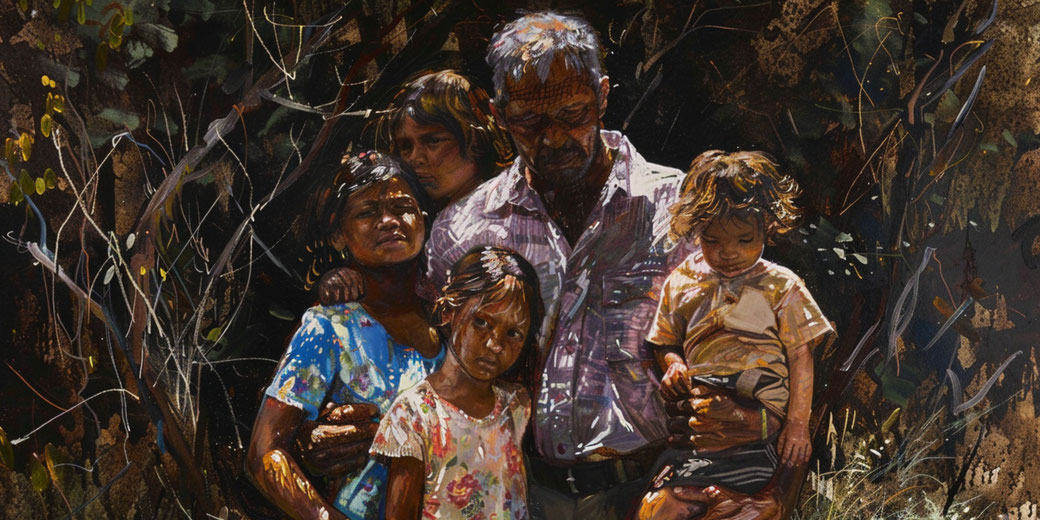The Stolen Generations in Australia: Why children were taken away from their own families

Between 1869 and 1970, the Australian government forcibly removed First Nations children from their families in a policy that became known as the Stolen Generations.
This dark period in civil rights history saw many of these children fostered out or adopted, or brought up in orphanages or other institutions.
In 1997, the Bringing Them Home report was released, which documented the impact of this devastating policy.
What were the 'Stolen Generations'?
The Stolen Generations is the term used to describe the practice of forcibly removing First Nations children from their families between 1869 and 1970.
Some of these children were fostered or adopted by white families, while many were brought up in orphanages, homes, or other institutions run by governments, churches, and welfare bodies.
The first use of the phrase ‘Stolen Generations’ occurred in 1981 by historian Peter Read, who was at the Australian National University at the time.
The primary motivation for implementing the Stolen Generations policy was to 'civilize' Indigenous Australian children and integrate them into white society.
A policy of assimilation was also used in an attempt to erase their culture and identity.
History of assimilation in Australia
The first 'native institution' at Parramatta was set up in 1814 to 'civilize' First Nations children, and a policy of assimilation was used in an attempt to integrate Indigenous Australian peoples into mainstream society.
The process of assimilation was looked after by each state government in Australia, and the organizations involved were often called Aborigines Protection Boards.
These bodies created the laws and resources that made the Stolen Generations possible, and each state had its own approach to the removal of children.
The 1909 Aborigines Protection Act in New South Wales granted the Aborigines Protection Board the power to remove Indigenous children from their families.
This was followed by the Aborigines Protection Amending Act 1915, that gave the government greater control over the lives of First Nations people and paved the way for the Stolen Generations policy.
Many state government policies required First Nations children over the age of 14 to find work.
The intent appears to have been the same regardless of the specific law or state government: to enculturate young First Nations children into European society in order to reduce their memory and use of traditional culture.
Assimilation policies were in place before the 1937 Commonwealth and State Conference on ‘native welfare’ occurred, which formalized the policy on a national level, with all states and territories agreeing to pursue assimilation as the primary policy objective.
A third conference, held in 1951, further confirmed the use of this policy.
It is estimated that between 10,000 and 100,000 Indigenous children were removed from their families between 1910 and 1970.
However, the exact number remains unknown due to poor record-keeping.
What was the impact of the policy?
The impact of the Stolen Generations policy was devastating. Many children experienced physical and emotional abuse, neglect, and displacement.
First Nations children were often not just separated from their parents, but also their brothers and sisters.
After being isolated from their family members, many children were placed in a series of different foster homes, and never felt settled in any of them.
The experience of separation and rejection had long-term impacts on the children's emotional health as they became adults.
The devastating consequences of the Stolen Generations policy are documented in the 1997 Bringing Them Home report.
The report documented the lifelong impacts of this traumatic experience, including poverty, social isolation, mental illness, and suicide.
This report found that the forcible removal of Indigenous Australian children had a devastating impact on their physical, emotional, and social well-being.
The trauma inflicted by this policy continues to be felt by many members of the Stolen Generations today.
What is being done to address the issue?
On February 13, 2008, the Prime Minister of Australia, Kevin Rudd, issued a formal apology to the Stolen Generations on behalf of all Australians.
Since then, a number of initiatives have been launched to support and commemorate the experiences of the Stolen Generations.
These include national archives and memorials, healing and reconciliation programs, and financial assistance for survivors.
In 2002, the first member of the Stolen Generations received financial compensation from the New South Wales Victims Compensation Tribunal.
Efforts to address the issue also include promoting awareness and education about the Stolen Generations and their experiences.
Schools and educational institutions have incorporated information about the Stolen Generations into their curricula to ensure that future generations are informed about this dark period in Australian history.
Reconciliation efforts between Indigenous and non-Indigenous Australians have also been an essential part of addressing the impacts of the Stolen Generations.
National Reconciliation Week, held annually from May 27 to June 3, is one such initiative that aims to foster respectful relationships between Indigenous and non-Indigenous Australians.
Despite these efforts, the legacy of the Stolen Generations continues to affect Indigenous communities today.
Intergenerational trauma, ongoing socio-economic disparities, and issues related to cultural identity persist.
While progress has been made, there is still much work to be done to ensure that the Stolen Generations and their descendants receive the support and recognition they deserve.
What do you need help with?
Download ready-to-use digital learning resources
Copyright © History Skills 2014-2025.
Contact via email
With the exception of links to external sites, some historical sources and extracts from specific publications, all content on this website is copyrighted by History Skills. This content may not be copied, republished or redistributed without written permission from the website creator. Please use the Contact page to obtain relevant permission.





